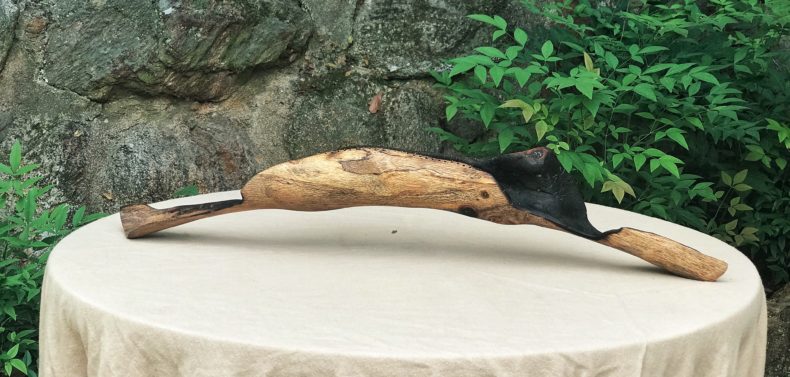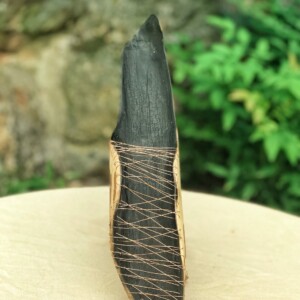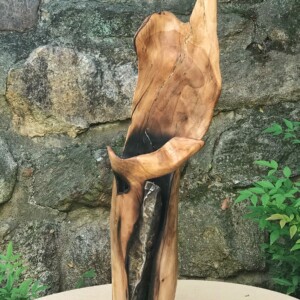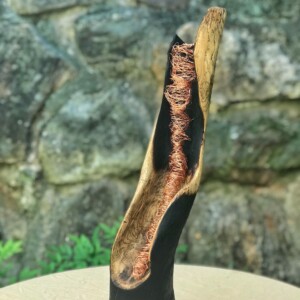The Willson Center for Humanities and Arts, in partnership with the UGA Graduate School, UGA Arts Council, Franklin College of Arts and Sciences, and Flagpole magazine, has awarded 34 micro-fellowships in its Shelter Projects program. The $500 fellowships support graduate students and community-based artists and practitioners in the creation of shareable reflections on their experience of the current pandemic through the arts and humanities.
Artist Statement by Chris Taylor: My work as a land artist led me nicely into this series. Most of work has been building people-sized bird nests using found wood. Nests are safe spaces used for rearing young and sheltering in times of crisis. Cocoons were the next logical evolution of this process for me. Representing hibernation, metamorphosis and safety, cocoons became my symbol during this time of immense social change. Cocoons are all hand carved using donated wood. Cooper wire and found sheet metal was also used. All pieces are protected with bees wax from a local apiary.
Flagpole: For many years now, your outdoor installations, such as the giant bird nests at the State Botanical Garden, have evoked a sense of wonder for those who stumble upon them. How has it felt to witness other people take a deeper interest in the natural world during a time when indoor activities are limited?
Chris Taylor: First, I’m thankful that I got to do what I did around town and at the garden before 2020, when people had a chance to see them. Secondly, I’m happy people are using the outdoors as a respite from shelter-in-place. But more importantly, I’m glad people are slowing down. Cooking more. Sleeping more. Reading, creating, staring into space… It’s heartbreaking that it’s taken a pandemic to slow the world down, but if there’s any up side to this, I hope people have reconnected, found a voice and have had a chance to take a breath.
June through September has been brutally hot and humid—even I can’t work outside when the weather is like this— but it’s been a pleasant surprise to see people walking around outside. The foot traffic in my neighborhood increased threefold in April; I saw people I’ve never seen before, heard kids playing when I never had in previous summers. It’s been kind of amazing.
Flagpole: Your artist statement describes a cocoon as a symbol of hibernation, metamorphosis and safety. How do you hope we collectively emerge on the other side of this “metamorphosis,” in terms of social, cultural or political change?
CT: Slowing down has been the most eye-opening side effect of the virus. It never occurred to me that people would start baking bread and sew and work around the house as much as we’ve seen. My optimism is reserved for this continuing for much longer; I know people are getting antsy.
Personally, I knew pretty early in that I needed to use this time to step onto a new creative trail. I had been stagnating since last fall and saw this as a good time to pick my artistic energy. Which is to say, I was getting lazy and needed to get my ass in gear again. I started journaling and writing haikus on Instagram just to have a goal everyday. I learned some calligraphy, created some sketchbooks and researched in earnest what I wanted my next project to be. I’ve been toying with the idea of power carving (carving with power tools like an angle grinder) for a while and had come into some wood. When this particular grant was announced, it all came together in one of those beautiful artistic moments—when you know not only what you’re going to do, but how you’re going to do it. Once I started, the project came together much quicker than I anticipated. It was a perfect storm of creativity and opportunity.
Flagpole: In Sandy Creek Nature Center’s recent interview with you, you encourage children to explore and make land art pieces of their own. From your experience as a father and arts educator, what lessons are important for us to share with the younger generation about the environment?
CT: The single most important thing to learn about the outdoors is that they’re there. I was raised in today’s vernacular as a free-range kid. I walked everywhere alone, and had the woods of northwest Georgia to play in. I have been fortunate enough to legitimize my play into an opportunity. After volunteering in the Clarke County School District, I saw that going outside isn’t an option for much of our community, and for those that could, they didn’t always understand it. I was given the chance by the school system, Sandy Creek Nature Center and the Lyndon House to take students outside and show them how to contextualize the outdoors as a canvas. I share my rules, explore, collect, collate and create, and watch what happens. You have to get your hands dirty, the sun will be in your eyes, you might get bitten or stung and you’re going to get thirsty, but instead of having these as barriers, they become not only challenges to overcome, but an integral part of being an artist. Muddy hands can lead to a multitude of creative choices, but you have to get muddy first.
Art is relegated to the classroom and the gallery. It’s not nearly as democratic as we like to think it is. I know some still see a career as an artist as a complete waste of time. If I was kid now, I don’t know that I would be into it either. But one student at a time, I’ve been able, hopefully, to share some insight into art. You don’t need supplies, you don’t need money, you don’t even need a room to do it in. You can literally, in the true sense of the word, do it anywhere. If you don’t have the opportunity to go outside to a natural setting, then use your porch or your stoop or the sidewalk, and using what you find, create something. It doesn’t have to be beautiful, it just has to be you.
We’re given this god-like ability to make things that never existed in this world before—that can be overwhelming when you think about it. But show a child this, and you just punched it to hyperspace and flew to a new world.
Like what you just read? Support Flagpole by making a donation today. Every dollar you give helps fund our ongoing mission to provide Athens with quality, independent journalism.
















